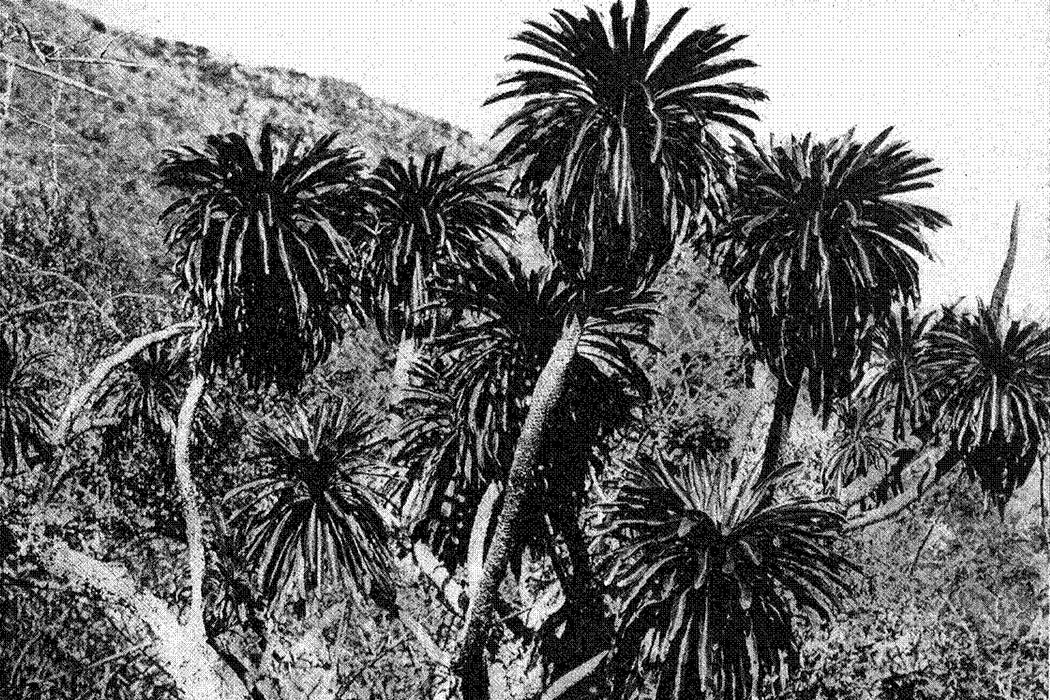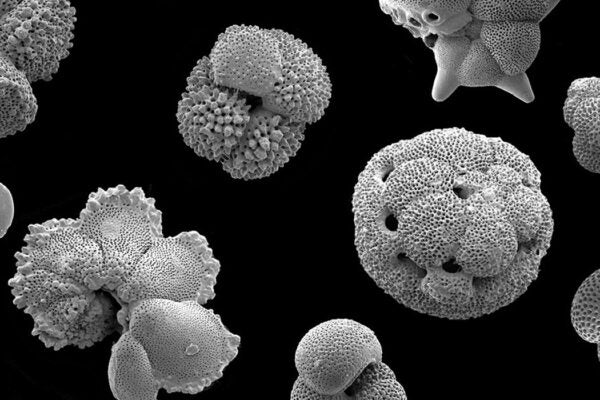The August 2023 wildfires on the Hawaiian island of Maui were some of the deadliest in US history. The wildfires, which killed approximately 97 people, also caused extreme ecological destruction to an already fragile landscape. As of 2022, there were more than 400 endangered plant species in Hawaiʻi; so many that the US Department of Land and Natural Resources refers to Hawaiʻi as the “Endangered Species Capital of the World.” But how many plants become extinct before they are ever “discovered”?
According to Arnoldia editor Matthew Battles, who brought this plant to my attention, Cyanea pohaku, a branched tree native to Maui, is one plant that was identified and taxonomized right before it disappeared. And had one scientist chosen not to photograph it, we may never have known it existed in the first place. Given the recent devastation on Maui, Cyanea pohaku’s history raises the question: how many other plants that haven’t been recorded within Western conventions of plant taxonomy and nomenclature have cultural and biological histories we may never know about?

The first evidence of Cyanea pohaku, which has no “common name,” was recorded by Joseph F. Rock, an Austrian American botanist who developed the first herbarium for the US Department of Agriculture in Hawaiʻi. When he found the plant on October 11, 1910, he took photographs and collected specimens; to this day, he is the only known person to have done so. He named it Clermontia haleakalensis after the mountain on which he encountered it. In 1988, approximately eighty years after it went extinct, plant biologist Thomas G. Lammers re-classified the plant to the Cyanea genus “on the basis of its habitat and floral features.”
Although Cyanea pohaku has no common name in Western taxonomies, it’s most likely that it did have a “common name” to Indigenous groups. As with many plants “discovered” by Western explorers, it had undoubtedly been spotted by locals. Rock was probably not the first person to encounter it, but rather, he was the first to record his encounter in a “credible” or “scientific” way. While initial research doesn’t point to Indigenous use or knowledge of Cyanea pohaku, it’s impossible to verify that.
The notion of “discovery” through collecting specimens and taking photographs highlights the credibility given to the recording practices of Western colonial explorers, which often ignores prior Indigenous experiences with those same plants, animals, or landmasses. These conventions include Carl Linnaeus’s binomial Latin naming system and the collection of multiple herbarium specimens of each newly “discovered” plant. These specimens are housed in arboreta and herbaria around the world, keeping Cyanea pohaku preserved in the archive, even though it was not preserved in the wild.
In A Monographic Study of the Hawaiian Species of the Tribe Lobelioideae Family Campanulaceae (1919), Rock described the plant in great detail, noting that it was
a small tree 6.5 m high, with few robust branches … leaves 20 to 30 cm long including the short margined petiole, fleshy, 1.5 to 4 cm wide, obtuse, oblong lanceolate, dark green above, pale underneath, midrib thick prominent, veins impressed, pellueid, the upper half erenate, lower half entire, glabrous, gradually tapering into a short margined petiole…
Cyanea pohaku lived at an elevation of 7,000 feet, “on the crater slopes of Puunianiau, a cone crate on the north-western slope of Mt. Haleakala on Maui.”
The three Cyanea pohaku specimens Rock encountered inhabited a very specific environment that would change dramatically just years after he recorded their existence. In his initial descriptions, published in 1913, he speculated that
it will not be long before they will have shared the fate of so many of our native trees, becoming extinct, as cattle have free access and browse on the lower branches within their reach. [I] appealed to the manager of Haleakala ranch to protect these trees from the ravages of cattle, which he kindly promised to do.
Yet, by the time he wrote his Monographic Study, he was reporting that Cyanea pohaku was nowhere to be found and proposed its extinction was most likely caused by grazing. The plants “were surrounded by their enemies, the cattle,” he wrote,
which browsed on their lowest branches and trampled under foot or devoured any seedling which might have dared show its cotyledons above ground even in what must now be considered unnatural surroundings and among foreign plant associates. Today the species has become extinct; not even a vestige of the trunks of these giants of Lobelioids remains to bear testimony to their previous existence.
The end of Cyanea pohaku, likely due to the consumption of seedlings by cattle, was caused by a human-driven phenomenon: an increased desire for meat. Unlike Cyanea pohaku, cattle aren’t native to Hawaiʻi, having been introduced to the islands in 1793 by British explorer George Vancouver, who hoped the animals would provide beef for ships crossing the Pacific Ocean. In her book Creatures of Empire, Virginia DeJohn Anderson notes that English colonists and American settlers “declared that livestock would improve the land and its native inhabitants.” An emphasis on cattle farming supported the European colonial ideal that equated accessibility of meat with “civility.” For native botanical inhabitants of Maui like Cyanea pohaku, the introduction of cattle meant that the plant can now only be found, flattened, as herbarium specimens.
![specimen of Isotype of Clermontia haleakalensis Rock [family LOBELIACEAE]](https://daily.jstor.org/wp-content/uploads/2023/10/cyanea_pohaku_the_plant_discovered_right_before_extinction_700.jpg)
Today, four other plants that Rock discovered are considered endangered. Conservation efforts, such as seed collecting, outplanting, and fencing, are being employed to save those species deemed worthy by the Hawaiian Department of Natural Resources and Department of Forestry. Some species, too, occasionally prove humans wrong and appear years after they were thought to be extinct. The brief lived existence of Cyanea pohaku in the Western botanical record demonstrates just how much large-scale agriculture, development, and climate change affect ecosystems; the decisions we make about what we value (and what we do not) matter. Over the next few years, the lasting impact of the Maui wildfires on plant life on the island will give a look into the fragility of plant life in the face of human-driven climate change. The Plant Humanities Initiative at Dumbarton Oaks seeks to highlight the stories of plants and their inextricable impact on the way our world functions.
Editor’s Note: This story was amended to give credit to Matthew Battles. In addition, Joseph F. Rock was erroneously called “John F. Rock” in the original publication.
Support JSTOR Daily! Join our membership program on Patreon today.








